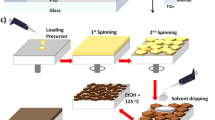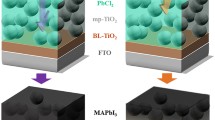Abstract
The anti-polar solvent technique is an effective way to improve the film quality in a perovskite solar cell. In this work, we reveal the reason why chlorobenzene (CBZ) plays an important role in controlling the crystallization process. By investigating the formation of intermediate phases in the precursor solution, we observed that the CH3NH3I (MAI)-PbI2-dimethylformamide (DMF) or MAI-PbI2-dimethylsulphoxide (DMSO) adducts have not yet formed until washed with non-polar solvent. The accelerated formation of intermediate phase yields high crystalline perovskite layers. Rapid solvent evaporation and retarded perovskite crystallization in one-step method are efficient to obtain high-quality perovskite films. Consequently, MAI-PbI2-DMSO intermediate shows neat rod-like structure with high crystallinity, which eventually transforms extremely dense and uniform perovskite films.
摘要
反溶剂技术可以有效改善钙钛矿薄膜的质量. 本文揭示了氯苯(CBZ) 在结晶过程中起的重要作用. 通过研究前体溶液中配合物的结 构变化, 我们观察到, 在滴加反溶剂之前, MAI-PbI2-DMF或MAI-PbI2-DMSO尚未形成. 快速去除多余溶剂后形成中间相, 延缓钙钛矿结晶是 得到高质量钙钛矿薄膜的关键. 其中MAI-PbI2-DMSO中间体表现出了高结晶的棒状结构, 因此最终转变成非常致密和均匀的钙钛矿薄膜.
Similar content being viewed by others
References
Kojima A, Teshima K, Shirai Y, et al. Organometal halide perovskites as visible-light sensitizers for photovoltaic cells. J Am Chem Soc, 2009, 131: 6050–6051
Kim HS, Lee CR, Im JH, et al. Lead iodide perovskite sensitized all-solid-state submicron thin film mesoscopic solar cell with efficiency exceeding 9%. Sci Rep, 2012, 2: 591
Burschka J, Pellet N, Moon SJ, et al. Sequential deposition as a route to high-performance perovskite-sensitized solar cells. Nature, 2013, 499: 316–319
Liu M, Johnston MB, Snaith HJ. Efficient planar heterojunction perovskite solar cells by vapour deposition. Nature, 2013, 501: 395–398
Zhang W, Saliba M, Moore DT, et al. Ultrasmooth organic-inorganic perovskite thin-film formation and crystallization for efficient planar heterojunction solar cells. Nat Commun, 2015, 6: 6142
Li X, Bi D, Yi C, et al. A vacuum flash-assisted solution process for high-efficiency large-area perovskite solar cells. Science, 2016, 353: 58–62
Zuo C, Ding L. Modified PEDOT layer makes a 1.52 V Voc for perovskite/PCBM solar cells. Adv Energ Mater, 2017, 7: 1601193
Zuo C, Bolink HJ, Han H, et al. Advances in perovskite solar cells. Adv Sci, 2016, 3: 1500324
Zuo C, Ding L. Bulk heterojunctions push the photoresponse of perovskite solar cells to 970 nm. J Mater Chem A, 2015, 3: 9063–9066
Li ZQ, Chen WC, Guo FL, et al. Mesoporous TiO2 yolk-shell microspheres for dye-sensitized solar cells with a high efficiency exceeding 11%. Sci Rep, 2015, 5: 14178
Xing G, Mathews N, Sun S, et al. Long-range balanced electronand hole-transport lengths in organic-inorganic CH3NH3PbI3. Science, 2013, 342: 344–347
Stranks SD, Eperon GE, Grancini G, et al. Electron-hole diffusion lengths exceeding 1 micrometer in an organometal trihalide perovskite absorber. Science, 2013, 342: 341–344
Huang F, Dkhissi Y, Huang W, et al. Gas-assisted preparation of lead iodide perovskite films consisting of a monolayer of single crystalline grains for high efficiency planar solar cells. Nano Energ, 2014, 10: 10–18
Zhang M, Yu H, Yun JH, et al. Facile preparation of smooth perovskite films for efficientmeso/planar hybrid structured perovskite solar cells. Chem Commun, 2015, 51: 10038–10041
Pascoe AR, Meyer S, Huang W, et al. Enhancing the optoelectronic performance of perovskite solar cells via a textured CH3NH3PbI3 morphology. Adv Funct Mater, 2016, 26: 1278–1285
Jeon NJ, Noh JH, Kim YC, et al. Solvent engineering for highperformance inorganic-organic hybrid perovskite solar cells. Nat Mater, 2014, 13: 897–903
Xiao M, Huang F, Huang W, et al. A fast deposition-crystallization procedure for highly efficient lead iodide perovskite thin-film solar cells. Angew Chem Int Ed, 2014, 53: 9898–9903
Shen D, Yu X, Cai X, et al. Understanding the solvent-assisted crystallization mechanism inherent in efficient organic-inorganic halide perovskite solar cells. J Mater Chem A, 2014, 2: 20454–20461
Hao F, Stoumpos CC, Liu Z, et al. Controllable perovskite crystallization at a gas-solid interface for hole conductor-free solar cells with steady power conversion efficiency over 10%. JAmChem Soc, 2014, 136: 16411–16419
Hao F, StoumposCC, Guo P, et al. Solvent-mediated crystallization of CH3NH3SnI3 films for heterojunction depleted perovskite solar cells. J Am Chem Soc, 2015, 137: 11445–11452
Ahn N, SonDY, Jang IH, et al. Highly reproducible perovskite solar cells with average efficiency of 18.3% and best efficiency of 19.7% fabricated via lewis base adduct of lead(II) iodide. J AmChem Soc, 2015, 137: 8696–8699
Li G, Zhang T, Zhao Y. Hydrochloric acid accelerated formation of planar CH3NH3PbI3 perovskite with high humidity tolerance. J Mater Chem A, 2015, 3: 19674–19678
Wu Y, Islam A, Yang X, et al. Retarding the crystallization of PbI2 for highly reproducible planar-structured perovskite solar cells via sequential deposition. Energ Environ Sci, 2014, 7: 2934–2938
Yang WS, Noh JH, Jeon NJ, et al. High-performance photovoltaic perovskite layers fabricated through intramolecular exchange. Science, 2015, 348: 1234–1237
Lee JW, Kim HS, Park NG. Lewis acid-base adduct approach for high efficiency perovskite solar cells. Acc Chem Res, 2016, 49: 311–319
Li W, Fan J, Li J, et al. Controllable grainmorphology of perovskite absorber film bymolecular self-assembly toward efficient solar cell exceeding 17%. J Am Chem Soc, 2015, 137: 10399–10405
Zuo L, Dong S, De Marco N, et al. Morphology evolution of high efficiency perovskite solar cells via vapor induced intermediate phases. J Am Chem Soc, 2016, 138: 15710–15716
Acknowledgments
This work was supported by the National Basic Research Program of China (2016YFA0202400 and 2015CB932200), the National Natural Science Foundation of China (21403247), the External Cooperation Program of BIC, Distinguished Youth Foundation of Anhui Province (1708085J09), Chinese Academy of Sciences (GJHZ1607), and STS project of Chinese Academy of Sciences (KFJ-SW-STS-152).
Author information
Authors and Affiliations
Corresponding authors
Additional information
Yingke Ren obtained his BSc degree from Hebei Normal University in 2011. He is a PhD candidate of the North China Electric Power University under the supervision of Prof. Jun Zhu and Prof. Songyuan Dai. His research interests mainly focus on perovskite solar cells.
Jun Zhu received his PhD degree from the University of Science and Technology of China in 2005. He joined Hefei Institutes of Physical Science, Chinese Academy of Sciences and was promoted to full professor in 2015. Now his research interests focus on the new generation solar cells, including quantum dot solar cells and perovskite solar cells.
Songyuan Dai is a professor and Dean of the School of Renewable Energy, North China Electric Power University. He obtained his BSc degree in physics from Anhui Normal University in 1987, and MSc and PhD degrees in plasma physics from the Institute of Plasma Physics, Chinese Academy of Sciences in 1991 and 2001, respectively. His research interests mainly focus on the next-generation solar cells including dye-sensitized solar cells, quantum dot solar cells, perovskite solar cells, etc.
Electronic supplementary material
Rights and permissions
About this article
Cite this article
Ren, Y., Duan, B., Xu, Y. et al. New insight into solvent engineering technology from evolution of intermediates via one-step spin-coating approach. Sci. China Mater. 60, 392–398 (2017). https://doi.org/10.1007/s40843-017-9027-1
Received:
Accepted:
Published:
Issue Date:
DOI: https://doi.org/10.1007/s40843-017-9027-1




